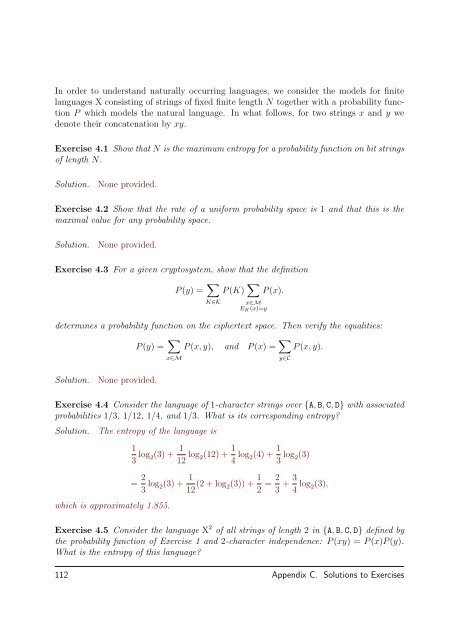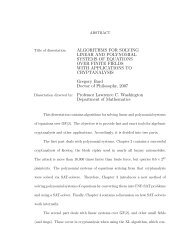where N is the total number of character pairs, and n xy is the number of occurrences ofthe pair xy, and the coincidence discriminant:∑ ∑x∈A y∈A(n xyN − ( ∑z∈An xz)( ∑Nz∈An zy) ) 2.NThe first term is the frequency of xy, and the latter is the product over the frequencies ofx as a first character and y as a second character. The coincidence discriminant measuresthe discrepancy between the probability space of pairs xy and the product probability space.What behavior do you expect for the coincidence index and coincidence discriminant ofthe above digraph decimation, if i and j were the positions of originally adjacent characters?Test your hypotheses with decimations of “real” English text, using the SAGEimplementations of coincidence index and coincidence discriminant.Why can we assume that i < j in the digraph sequence? What is the obstacle to extendingthese statistical measures from two to more characters?Solution. If i and j are the ciphertext images of adjacent positions k, k + 1, in each blockof length m, then the sequencec i c j , c i+m c j+m , c i+2m c j+2m , . . .will have the coincidence index and coincidence discriminant of the plaintext. Note thatthe measures are invariant under a substitution, so can be used to break a combinationsubstitution-transposition cipher, by first breaking the transposition. The result will be asequence i 1 , i 2 , . . . , i m of indices of positions which “want” to be associated.Note that the measures, coicidence index and coincidence discriminant, will also be thesame for the sequencec j c i , c j+m c i+m , c j+2m c i+2m , . . .so we do not directly distinguish the correct order from its reverse, i m , . . . , i 2 , i 1 . This onebit of information can be determined at the end, with the savings of being able to assumei < j in testing for statistically associated pairs {i, j}.Note also that for the incorrect period m there will be little or no tendency for statisticalassociation of characters, so by first varying the triples (i, j, m), with fixed i = 1 and1 < j ≤ m, we can determine the probable period m and then recover the entire sequencei 1 , i 2 , . . . i m by letting i vary.Information Theory111
In order to understand naturally occurring languages, we consider the models for finitelanguages X consisting of strings of fixed finite length N together with a probability functionP which models the natural language. In what follows, for two strings x and y wedenote their concatenation by xy.Exercise 4.1 Show that N is the maximum entropy for a probability function on bit stringsof length N.Solution.None provided.Exercise 4.2 Show that the rate of a uniform probability space is 1 and that this is themaximal value for any probability space.Solution.None provided.Exercise 4.3 For a given cryptosystem, show that the definitionP (y) = ∑ K∈KP (K) ∑ P (x).x∈ME K (x)=ydetermines a probability function on the ciphertext space. Then verify the equalities:P (y) = ∑ x∈MP (x, y), and P (x) = ∑ y∈CP (x, y).Solution.None provided.Exercise 4.4 Consider the language of 1-character strings over {A, B, C, D} with associatedprobabilities 1/3, 1/12, 1/4, and 1/3. What is its corresponding entropy?Solution.The entropy of the language iswhich is approximately 1.855.13 log 2(3) + 1 12 log 2(12) + 1 4 log 2(4) + 1 3 log 2(3)= 2 3 log 2(3) + 1 12 (2 + log 2(3)) + 1 2 = 2 3 + 3 4 log 2(3),Exercise 4.5 Consider the language X 2 of all strings of length 2 in {A, B, C, D} defined bythe probability function of Exercise 1 and 2-character independence: P (xy) = P (x)P (y).What is the entropy of this language?112 Appendix C. Solutions to Exercises
- Page 1 and 2:
Author (David R. Kohel) /Title (Cry
- Page 4 and 5:
CONTENTS1 Introduction to Cryptogra
- Page 6:
PrefaceWhen embarking on a project
- Page 10 and 11:
information. We introduce here some
- Page 12 and 13:
ut strings in A ∗ map injectively
- Page 14 and 15:
CHAPTERTWOClassical Cryptography2.1
- Page 16 and 17:
LV MJ CW XP QO IG EZ NB YH UA DS RK
- Page 18 and 19:
As a special case, consider 2-chara
- Page 20 and 21:
Note that if d k = 1, then we omit
- Page 22:
ExercisesSubstitution ciphersExerci
- Page 25 and 26:
Ciphertext-only AttackThe cryptanal
- Page 27 and 28:
of size n, suppose that p i is the
- Page 29 and 30:
Note that ZKZ and KZA are substring
- Page 31:
Checking possible keys, the partial
- Page 34 and 35:
sage: X = pt.frequency_distribution
- Page 36 and 37:
CHAPTERFOURInformation TheoryInform
- Page 38 and 39:
For each of these we can extend our
- Page 40 and 41:
in terms of the cryptosystem), then
- Page 42 and 43:
CHAPTERFIVEBlock CiphersData Encryp
- Page 44 and 45:
Deciphering. Suppose we begin with
- Page 46 and 47:
The Advanced Encryption Standard al
- Page 48 and 49:
1. Malicious substitution of a ciph
- Page 50 and 51:
locks M j−1 , . . . , M 1 as well
- Page 52:
where X = K ⊕ M = (X 1 , X 2 , X
- Page 55 and 56:
6.2 Properties of Stream CiphersSyn
- Page 57 and 58:
Exercise. Verify that the equality
- Page 59 and 60:
n 2 n − 11 12 33 74 155 316 637 1
- Page 61 and 62:
Exercise 6.6 In the previous exerci
- Page 63 and 64:
Exercise 6.9 Compute the first 8 te
- Page 65 and 66: which holds since −4 = 17 + (−1
- Page 67 and 68: must therefore have a divisor of de
- Page 69 and 70: Shrinking Generator cryptosystemLet
- Page 72 and 73: CHAPTEREIGHTPublic Key Cryptography
- Page 74 and 75: Initial setup:1. Alice and Bob publ
- Page 76 and 77: We apply this rule in the RSA algor
- Page 78 and 79: the discrete logarithm problem (DLP
- Page 80 and 81: Man in the Middle AttackThe man-in-
- Page 82: Exercise 8.6 Fermat’s little theo
- Page 85 and 86: k < p − 1 with GCD(k, p − 1) =
- Page 88 and 89: CHAPTERTENSecret SharingA secret sh
- Page 90: using any t shares (x 1 , y 1 ), .
- Page 93 and 94: sage-------------------------------
- Page 95 and 96: sage: x.is_unit?Type:builtin_functi
- Page 97 and 98: Python (hence SAGE) has useful data
- Page 99 and 100: sage: n = 12sage: for i in range(n)
- Page 101 and 102: sage: I = [55+i for i in range(3)]
- Page 103 and 104: sage: I = [7, 4, 11, 11, 14, 22, 14
- Page 105 and 106: ExercisesRead over the above SAGE t
- Page 107 and 108: 102
- Page 109 and 110: Solution. The block length is the n
- Page 111 and 112: Solution.below.The coincidence inde
- Page 113 and 114: analysis of the each of the decimat
- Page 115: arbitrary permutation of the alphab
- Page 119 and 120: We do this by first verifying the e
- Page 121 and 122: Solution.None provided.Linear feedb
- Page 123 and 124: Multiplying each through by the con
- Page 125 and 126: Solution. The linear complexity of
- Page 127 and 128: If a, b, and c are as above, then f
- Page 129 and 130: Exercise 8.5 Use SAGE to find a lar
- Page 131 and 132: Solution. Now we can verify that e
- Page 133 and 134: which has no common factors with p
- Page 135 and 136: sage: p = 2^32+61sage: m = (p-1).qu
- Page 137 and 138: sage: a5 := a^n5sage: c5 := c^n5sag
- Page 139 and 140: The application of this function E
- Page 141 and 142: 5. (∗) How many elements a of G h
- Page 143: 1. The value f(0) of the polynomial
















